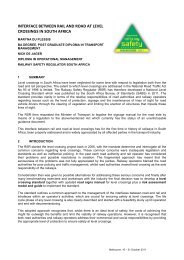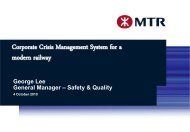successful interface risk management - International Rail Safety ...
successful interface risk management - International Rail Safety ...
successful interface risk management - International Rail Safety ...
Create successful ePaper yourself
Turn your PDF publications into a flip-book with our unique Google optimized e-Paper software.
Axel Kappeler, James Catmur<br />
Arthur D. Little<br />
Successful <strong>interface</strong> <strong>risk</strong> <strong>management</strong> – from blame culture to joint action<br />
Interfaces are important because they are everywhere. However, <strong>interface</strong>s can be a problem, for example<br />
because responsibilities are not clearly defined, the exchange of information is not smooth or different<br />
parties have different incentives affecting their behaviour towards managing <strong>interface</strong> <strong>risk</strong>s.<br />
Current approaches for managing safety <strong>risk</strong>s at <strong>interface</strong>s often only consider technical aspects especially<br />
the interaction between systems or sub-systems. Some include considerations of man-machine <strong>interface</strong>s<br />
but few consider organisational <strong>interface</strong>s.<br />
For example, MIL Standard 882 requires the creation of a System <strong>Safety</strong> Programme Plan (SSPP). This<br />
requires defining “the safety <strong>interface</strong>s between each associate contractor and subcontractor (and suppliers<br />
and vendors as applicable), e.g. integrating hazard analyses”. Preliminary Hazard Analysis (PHA), carried<br />
out as part of the safety analysis, “shall identify hazards by considering the potential contribution to<br />
subsystem or system mishaps from” … “Interface considerations to other systems when in a network or<br />
System-of-Systems (SoS) architecture.” System Hazard Analysis (SHA) is carried out “to identify previously<br />
unidentified hazards associated with the subsystem <strong>interface</strong>s and faults” … “including software and<br />
subsystem and human <strong>interface</strong>s.” [2]<br />
The terms of reference for the NATO Research and Technology Organisation (NATO RTO) report<br />
‘Validation, verification and certification of embedded systems’ states as one of its specific goals: Interface<br />
testing techniques for embedded systems which could include both specialized and Commercial-Off-The-<br />
Shelf (COTS) components. In addition chapter 4.5 of the report considers Man Machine Interfaces. [3]<br />
The Common <strong>Safety</strong> Method (CSM) on <strong>risk</strong> evaluation and assessment states that “particular attention<br />
should be paid to <strong>risk</strong> <strong>management</strong> at the <strong>interface</strong>s between the actors which are involved in the application<br />
of this Regulation.” Interfaces are defined as “all points of interaction during a system or subsystem lifecycle,<br />
including operation and maintenance where different actors of the rail sector will work together in<br />
order to manage the <strong>risk</strong>s.” Annex I of the regulation states that “for each <strong>interface</strong> relevant to the system<br />
under assessment … the rail-sector actors concerned shall cooperate in order to identify and manage jointly<br />
the hazards and related safety measures that need to be handled at these <strong>interface</strong>s”. [4]<br />
The NASA Risk Management Handbook describes two complementary processes, integrated into a single<br />
coherent framework, in order to foster proactive <strong>risk</strong> <strong>management</strong> - Risk-Informed Decision Making (RIDM)<br />
and Continuous Risk Management (CRM). “The RIDM process addresses the <strong>risk</strong>-informed selection of<br />
decision alternatives to assure effective approaches to achieving objectives.” “The CRM process addresses<br />
implementation of the selected alternative to assure that requirements are met.”<br />
“Throughout the RIDM process, interactions take place between the stakeholders, the <strong>risk</strong> analysts, the<br />
Subject Matter Experts (SMEs), the Technical Authorities, and the decision-maker to ensure that objectives,<br />
values, and knowledge are properly integrated and communicated into the deliberations that inform the<br />
decision.”<br />
The RIDM process requires that within each unit the <strong>interface</strong>s with the unit(s) at the next higher and lower<br />
levels in the organizational hierarchy are considered (e.g. when negotiating objectives and establishing<br />
performance requirements), as well as with its own unit’s CRM process. [5]<br />
Non-technical <strong>interface</strong>s, such as those between two organisations, different departments within an<br />
organisation, two projects or a number of workstreams within a project are often not systematically analysed<br />
for their safety <strong>risk</strong>s. Therefore, <strong>risk</strong> <strong>management</strong> approaches need to be extended to these non-technical<br />
<strong>interface</strong>s.<br />
But current <strong>risk</strong> <strong>management</strong> approaches, as well as the attitudes and behaviours of key players at such<br />
<strong>interface</strong>s, are often not well suited to identify, assess and manage safety <strong>risk</strong>s at <strong>interface</strong>s. Each party is<br />
typically only looking at their own ‘patch’ and, more often than not, blaming the other side if something goes<br />
wrong.<br />
London, 8 – 10 October 2012















